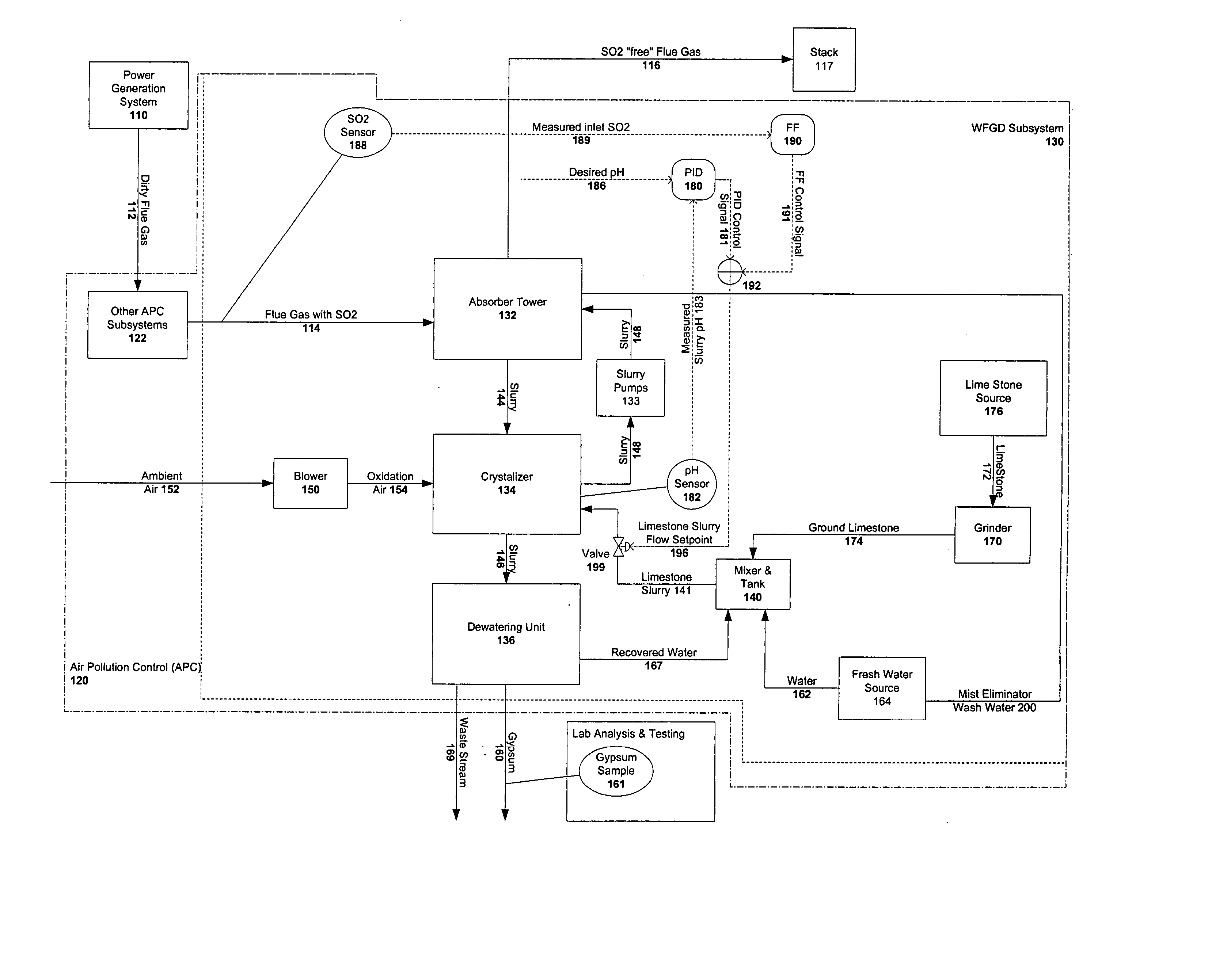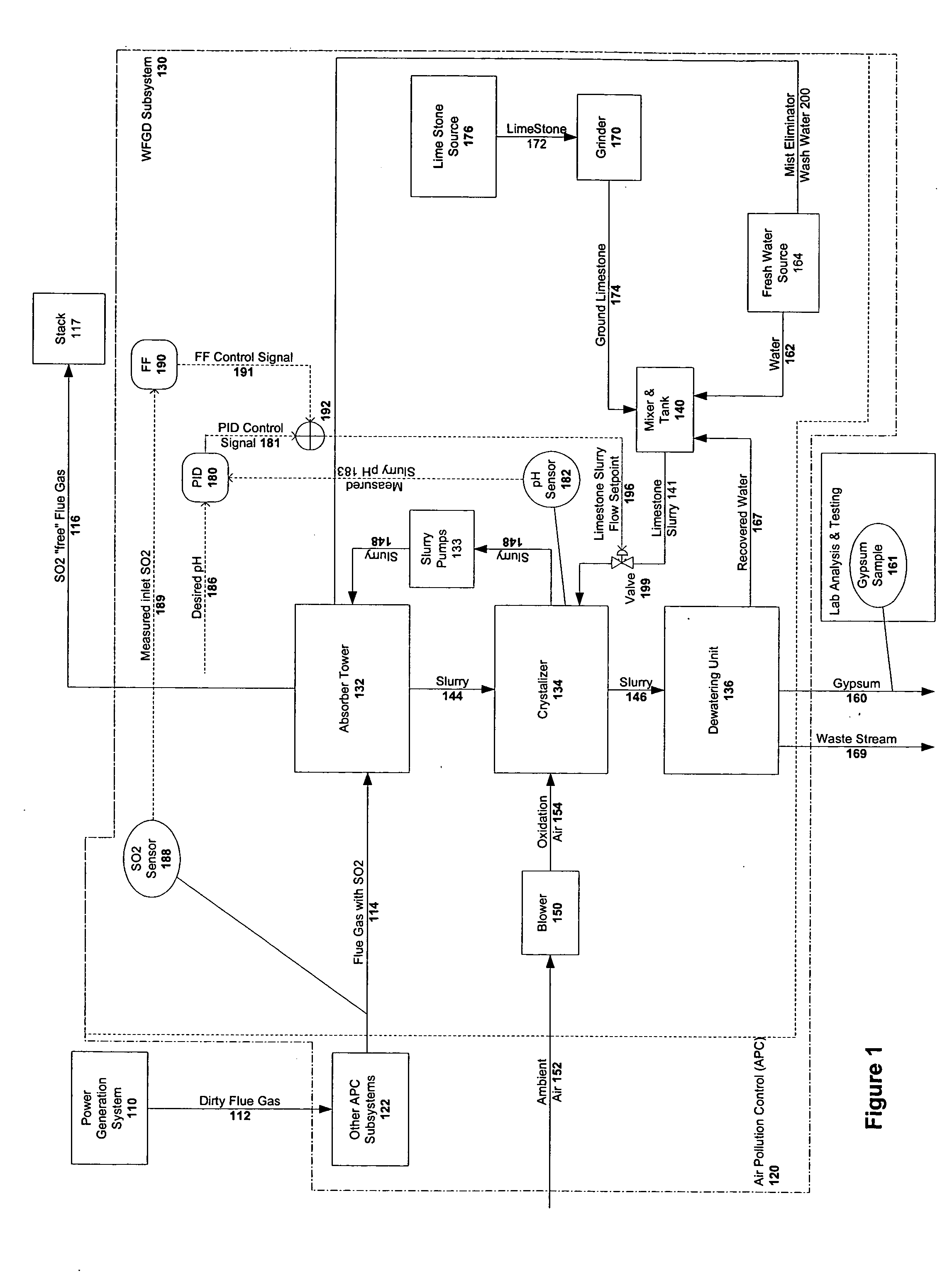These other reactants are typically more expensive and are not currently cost-competitive with the limestone reactant.
These pumps are some of the largest pumps in the world and they are driven by
electricity that could otherwise be sold directly to the
power grid (parasitic
power load).
No direct on-line measurement of
gypsum purity is conventionally available.
This is because application of the derivative element is not particularly beneficial for this type of control application.
Thus, without the
feed forward loop, it is very difficult for the PID 180 to provide adequate control over a wide range of pH with the same tuning constants.
That is, there may be a conflict between meeting the SO2 emission requirements and the
gypsum quality requirements.
The higher the
slurry is introduced into the
tower, the more
contact time it has with the
flue gas resulting in more SO2 removal, but this additional SO2 removal comes at the penalty of increased
power consumption to pump the
slurry to the higher spray level.
The addition of this extra spray level adds to the capital costs of the absorber
tower and hence the subsystem.
However, these additives tend to be expensive and therefore their use will result in increased
operational costs, which may, over time, offset the savings in capital costs.
However, there is an upper limit to the amount of
oxygen that can be absorbed or held by
slurry.
However, because it is not possible to measure the O2 in the slurry, the level of O2 in the slurry is not used as a constraint on conventional WFGD subsystem operations.
Thus, there is no way of accurately monitoring when the slurry within the crystallizer 134 is becoming starved for O2.
With insufficient oxidation,
sulfite limestone blinding can occur resulting in poor
gypsum quality, and potentially subsequent lower SO2 removal efficiency, and a high
chemical oxygen demand (COD) in the waste water.
Without proper compensating adjustments, this can lead to high
sulfite concentrations in the slurry, which in turn results in limestone blinding, lower absorber
tower 132 SO2 removal efficiency, poor gypsum quality, and a high
chemical oxygen demand (COD) in the
wastewater.
In making these conservative selections, the operator often, if not always, sacrifices minimum-cost operation.
However, by guaranteeing the gypsum purity, the operator often sacrifices the SO2 removal efficiency.
However, by selecting this
setpoint for pH, the operator sacrifices 3% of the SO2 removal efficiency.
However, because the relationship between the power costs and SO2 removal efficiency is not well understood by most operators, operators will typically take a conservative approach.
On the other hand, controlling emissions to the rolling-average limit is more complex.
In either case, there is no explicit control of the rolling-average emissions, and therefore no way to ensure compliance with the rolling-average limit or prevent costly over-compliance.
In addition, side reactions may produce undesirable by-products:
ammonium sulfate, (NH4)2SO4, and
ammonium bisulfate, NH4HSO4.
This is a greater problem with high-
sulfur coals, caused by higher SO3 levels resulting from both higher initial SO3 levels due to fuel
sulfur content and oxidation of SO2 in the SCR reactor.
However, there is often no calculation or on-line measurement of
ammonia slip.
Not only does this salt reduce the heat-transfer across the
air preheater it also attracts ash that further reduces the heat-transfer.
Abrupt decreases in the
flue gas /
NOx load can result in abnormally high short-term
ammonia slip.
If the ammonia concentration of the
fly ash becomes too great there can be a significant expensive associated with disposal of the
fly ash.
By conservatively selecting a
setpoint for
NOx, the operator / engineer reduces the overall removal efficiency of the SCR.
No attempt to actually control or optimize temperature is made in most cases.
Unfortunately, the
NOx distribution profile is a function of not just the ductwork, but also boiler operation.
Standard controllers do not account for the fact that the NOx inlet and velocity profiles to the SCR are seldom uniform or static.
That is, when the inlet conditions to the SCR are changing thus requiring modulation of the ammonia
injection rate, it is unlikely that the
feedback control of NOx reduction efficiency will be able to prevent significant excursions in this
process variable.
Rapid load transients and
process time delays are dynamic events, which can cause significant process excursions.
Catalyst Decay: The catalyst decays over time reducing the removal efficiency of the SCR and increasing the ammonia slip.
There is little effort applied to improving
dynamic control of the SCR during load transients or to optimizing operation of the SCR.
Selecting the optimal instantaneous, and if possible, rolling-average NOx removal efficiency is also an elusive and changing problem due to business, regulatory / credit, and process issues that are similar to those associated with optimal operation of the WFGD.
Other APC processes exhibit problems associated with: Controlling / optimizing dynamic operation of the process, Control of byproduct / co-product quality, Control of rolling-average emissions, and Optimization of the APC asset.
 Login to View More
Login to View More 


